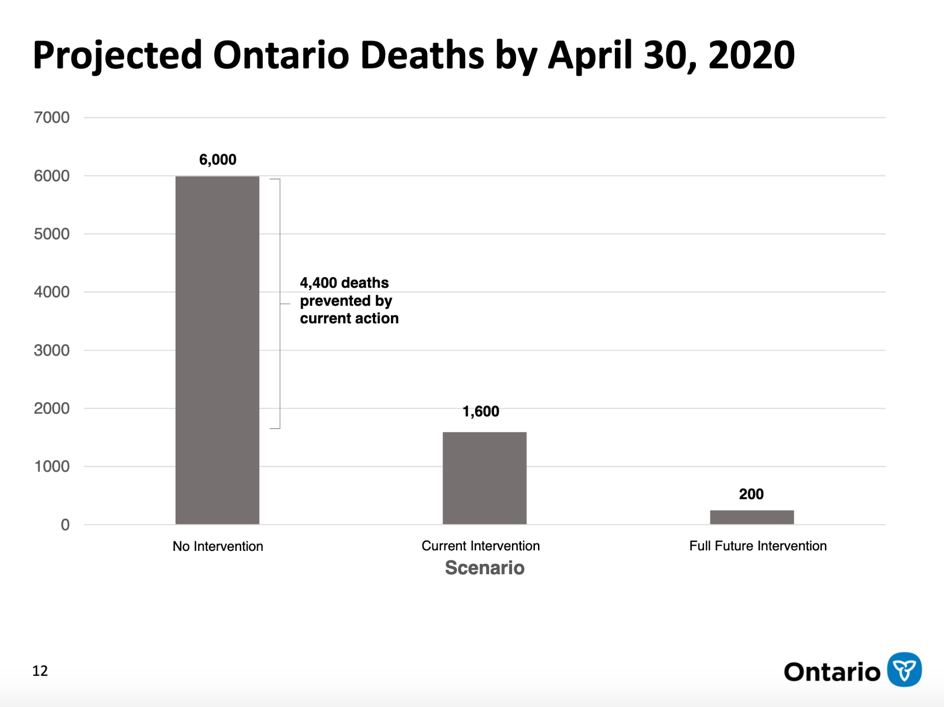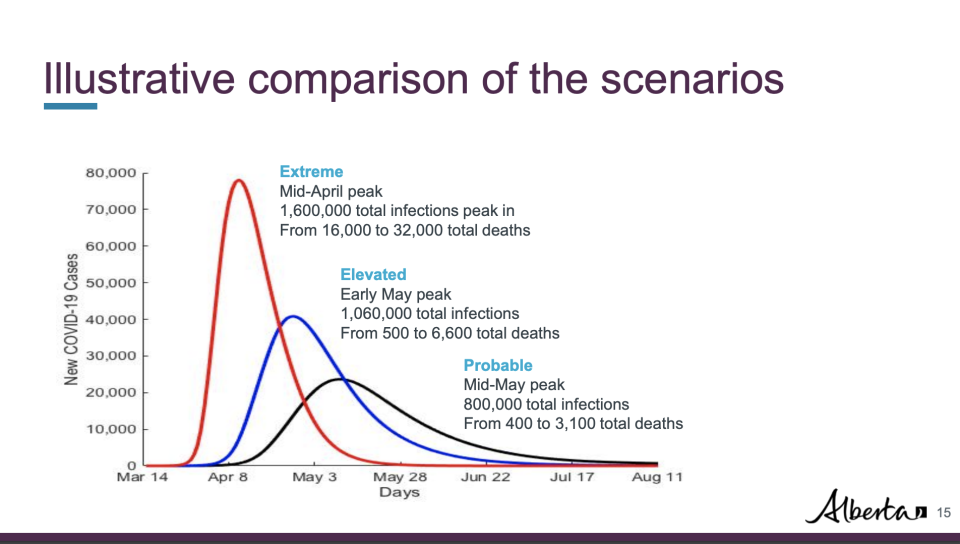The future of COVID-19: All of Canada's projections of infection so far
Yahoo News Canada is committed to providing our readers with the most accurate and recent information on all things coronavirus. We know things change quickly, including some possible information in this story. For the latest on COVID-19, we encourage our readers to consult online resources like Canada’s public health website, World Health Organization, as well as our own Yahoo Canada homepage.
As cases of COVID-19 continue to spread around the world, Canadians seem to be increasingly concerned about their health and safety
Currently, there are more than 18,000 confirmed coronavirus cases in Canada more than 400 deaths.
Check back for the latest updates on the coronavirus outbreak in Canada.
For a full archive of the first month of the pandemic, please check our archive of events.
Canada’s projections for COVID-19 predict up to 22,000 deaths
The federal government has released the modelling data forecasting the impact of COVID-19 across Canada.

For the short-term epidemic track of the virus, it’s predicted that Canada will see 27,215 cases Apr. 16. The lower prediction limit would see 22,580 cases and the upper prediction limit is 31,850. This could result in between 500 and 700 deaths by Apr. 16.
Experts have made their predictions using two models, one with stronger epidemic control, with a high degree of physical distancing, contract tracing and cases isolated. The weaker control has a lower degree of these public health measures.

Stronger epidemic control:
There will be a 1 to 10 per cent infected rate peaking and the end of spring, beginning of summer and ending in the fall.
Between 11,000 and 22,000 deaths in Canada are predicted.
There will be between 73,000 and 146,00 hospitalizations, and between 23,000 and 46,000 in intensive care.
Weaker epidemic control:
There will be a 25 to 50 per cent infected rate peaking between summer and fall, ending in spring 2021.
More than 200,000 deaths are expected to occur in Canada.

Dr. Theresa Tam was, Canada's Chief Public Health Officer, said Canada is “fairly early on” in the epidemic and a “high and sustained degree of physical distancing” is essential to maintain the stronger epidemic control scenario.
“It’s a matter of life and death,” she said, adding that she believes the country has a “very good chance” of staying in the stronger epidemic control model.
“We must do everything that we can now to remain in that best care scenario,” Dr. Tam said.
Deputy Chief Public Health Officer Howard Njoo said the first wave of the outbreak could end by summer but anticipates multiple smaller waves will follow. He added that predicting the lifespan of the virus for Canada is difficult because all province and territories have their own epidemic curve and timeframe.
Dr. Tam said even when Canada has hit the peak of the curve and the outbreak is on its way down, the country will need to have “highly sensitive” testing for any possible new infections, and continue to practice strong social distancing measures.
“We’re looking for...the slowing down of that growth rate,” Dr. Tam said. “These models are very sensitive to our actions.”
Province reveal projections for COVID-19
Ontario
Ontario has released its modelling data with possible forecasts for the outcome of the COVID-19 pandemic in the province.
The main message from experts is that each person in Ontario needs to do their part to stop the spread of the virus, highlighting that the public will impact the eventual outcome.
“The outcome is in the public’s hands,” Peter Donnelly, president and CEO of Public Health Ontario said on Friday. “It’s about breaking the chain of infection and it’s very important that we all realize...we have a personal opportunity to do that.”
“This isn’t about flattening the curve, it’s about chopping the head off the top.”

Donnelly said that we are “some way off” from lifting any measures currently in place to prevent the spread of the virus.
He added that “bearing down hard now” will result in the virus coming to an end and the economy bouncing back more quickly.
Donnelly also highlighted that modelling is a very “inexact” science, particularly for a new virus. As a reference, Ontario loses 1,350 people to normal seasonal flu per year.
Deaths without public health measures (without any intervention at all) are expected to be 100,000 in Ontario, lowered to between 3,000 and 15,000 with the current public health measures in place.
The data shows that the measures put in place, including physical distancing, self-isolation following travel, prohibiting large gatherings and work from home arrangements, have been effective to slow the spread of COVID-19.
Projected cases in the province, without any intervention, is 300,000 cases by Apr. 30 but the forecast with the current measures is 80,000 cases.
Projected deaths with no intervention is 6,000 by Apr. 30, with the current measures the modelling has predicted 1,600 deaths.
The lifespan of COVID-19 in the province could be between 18-months and two years.

Matthew Anderson, president and CEO of Ontario Health said that currently, hospitals have the capacity to mange COVID-19 patients but if there is a spike in hospitalizations, it would be “very difficult” to project.
There are currently 410 ICU beds available for COVID-19 patients with 900 additional beds can be added.
The “worst case” forecast for Ontario ICU capacity predicts more than 3,400 beds will be needed by the end of the month. The “best case” would see the need top out just over 1,200 around Apr. 18, getting lower as the month progresses.

For a full look at Ontario’s COVID-19 projections, visit the Government of Ontario’s site.
Alberta
There are three different scenarios for Alberta: probable, elevated and extreme.

Probable scenario:
Expected to be the “most likely” situation for Alberta
For every case, one to two more people are infected
Infections will peak in mid-May
800,000 infections by the end of summer
There will between 400 and 3,100 deaths
Hospitalizations will peak in late May at around 818 and individuals needing critical care will peak in late May, early June with around 232 people
Elevated scenario:
For every case, two more people are infected
Infections will peak in early May
1,060,000 infections across the province
There will between 500 and 6,600 deaths
Hospitalizations will peak at the beginning of May at around 1,570 and individuals needing critical care will peak in early May with around 392 people
Extreme scenario:
Shows what would have happened if Alberta did not undertake the interventions in place
For every case, three people are infected
Infections will peak in mid-April
1,600,000 infections across the province
There will between 16,000 and 32,000 deaths
For a full look at Alberta’s COVID-19 projections, visit the Government of Alberta site.
Saskatchewan
Saskatchewan has released its modelling data detailing the forecast for the COVID-19 outbreak in the province.

Saskatchewan’s high range scenario, predicting one person with the virus will infect four people, would see 408,000 cumulative COVID-19 cases and 8,370 total deaths.
The mid range estimate, predicting one person with the virus will infect 2.76 people, has cumulative cases at 262,000 in Saskatchewan and 5,260 deaths.
The low range scenario, predicting one person with the virus will infect 2.4 people, estimates that there will be 153,000 cumulative COVID-19 cases in the province and 3,075 deaths.
“While we understand Canadian data is starting to show some hopeful signs about flattening the curve on COVID-19, it is critical to remember not to be complacent,” Saskatchewan Health Authority CEO Scott Livingstone said in a statement. “We need to continue to escalate our response to ensure we are prepared for the worst case scenarios and we need the public to help us avoid those scenarios.”
For a full look at Saskatchewan’s COVID-19 projections, visit the Government of Saskatchewan site.
Quebec
Quebec officials released modelling data forecasting the impact of COVID-19 in the province by the end of April.

The optimistic projections, comparing provincial data to Portugal, show:
29,212 confirmed cases of the virus by Apr. 30
A peak of 1,404 people in hospital around Apr. 21 and 468 people in intensive care
1,263 deaths in the province by Apr. 30.
The worst-case projections, comparing provincial data to Italy, show:
59,845 confirmed cases of the virus by Apr. 30
A peak of 3,028 people in hospital around Apr. 15 and 1,009 people in intensive care
8,860 deaths in the province by Apr. 30
Earlier on Tuesday, Quebec’s total number of deaths increased to 150. There were also 760 more confirmed COVID-19 cases in the province, 9,340 in total.
Quebec Premier Francois Legault was pleased to announce that the number of people in intensive care has not increased since Monday, 164, and highlighted that no one in the province should relax any of the physical distancing or other public health measures in place.
For a full look at Quebec’s COVID-19 projections, visit the Government of Quebec site.

 Yahoo News
Yahoo News 


